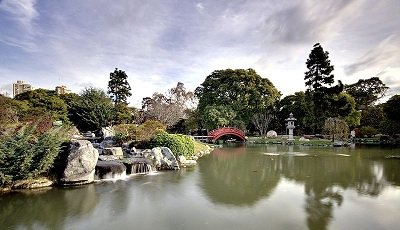Japanese Gardening Style also created an impact on Modern Garden Architecture. All of us know that Japanese people are known for their perfection.
In this article, we are going to discuss the evolution of Japanese Gardens and also study the reasons for which they are renowned as “Perfectionists”….

Japanese Gardens evolved under the influence of distinctive Chinese Gardening Style…. These gardens were developed wherever there was a need for a landmark. For instance, Historical Landmarks such as Buddhist Temples, Shrines and castles.
Later on, Japaneses gardening Style was also employed for making Private Gardens in residences, city Parks or any free space around the residential and commercial complexes that could be used as a garden. They used various landscape elements and developed their typical gardening style.
Japanese not only created Green Gardens but they also designed “Dry Gardens” which are also “Rock Gardens”. The tradition of the Tea Masters Japanese gardens of quite another style, evoking rural simplicity.

The tradition of Japanese gardening was historically passed down from sensei to apprentice. In recent decades this has been supplemented by various trade schools. However, the opening words of Zen’s Illustrations for designing mountain, water and hillside field landscapes (1466) are “If you have not received the oral transmissions, you must not make gardens” and its closing admonition is “You must never show this writing to outsiders. You must keep it secret”.
Japanese Gardens have their own typical style of maintaining the garden. They create a hub at the centre from where the entire garden can be viewed.
Here are some of the elements most commonly used in Japanese Gardens:
- A lantern, typically of stone
- A teahouse or pavilion
- An enclosure device such as a hedge, fence, or wall of traditional character
- A bridge to the island, or stepping stones
Why are Japanese Gardeners called “Perfectionists”?
The Japanese garden for the permanent picture. They will go to any length to perfect a view and to keep it so unaltered year after year. The backbone of a Japanese garden is the rock and the evergreen. Thus seasonal changes in this static stage become dramatic since plant group after group, flower.
The Japanese contribution to the Chinese model was in planting. Zen Buddhism preached canons on art, which avoided the trite, the obvious, the emphatic. By the year 1200, the naturalistic garden was mature. The moss garden in Kyoto with its dry cascade with flat topped boulders, the Ryoanji (1490) dry landscape with 15 boulders on a bed of gravel are famous examples. The Chinese Sung style with rocks was to set them boldly on their ends and was still a part of the Japanese garden.
Maintenance of Japanese Gardens
The maintenance of the Japanese garden is mainly in pruning trees to maintain proportion and harmony with the surrounding garden. The small temple courtyard was arranged as a contemplative garden. The tea ceremony was invented in the 15th century. The path to the teahouse was symbolic as the place of preparation. The plants were pine, plum, cherry and heavenly bamboo. Another style of gardening came into being. Where real hills are seen, they are borrowed into the horizon of the composition. Flowers are in clusters of pots outside the kitchen door.
English Gardening also carried some influence from the Japanese Gardening Style… Persian Gardening Style, Italian, Dutch and French Gardening Style developed much earlier than the Japanese Garden Architecture… And yet it was so different and unique though it had some similar character as that of Chinese Gardening style that we discussed earlier…
I already saw a hundred japanese gardens and they all look remarkable! They all carry the sense of royalty and sincerity! If I would be given a choice between my garden and a new Japanese style garden, i would go for the Japanese garden!